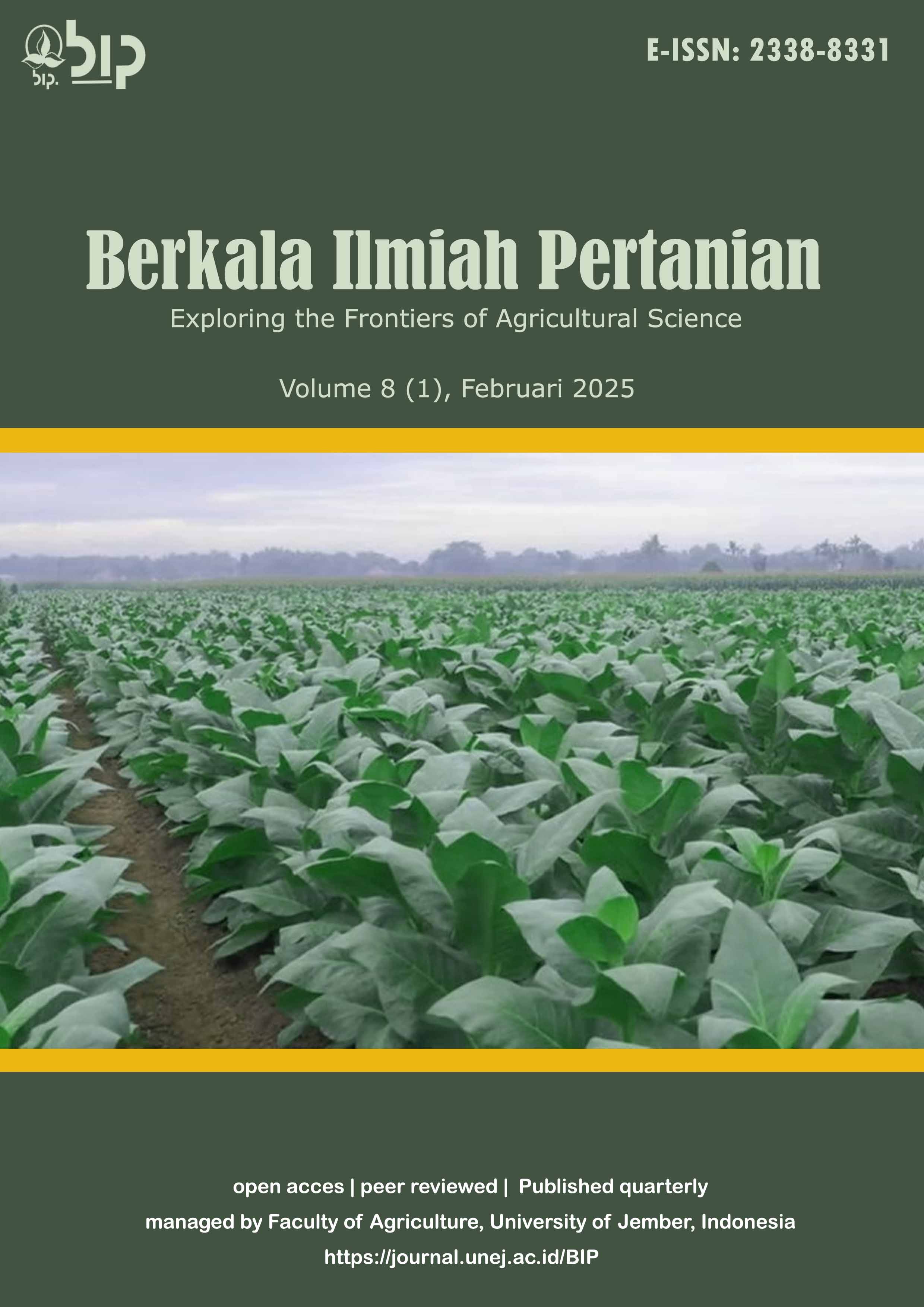The Effect of Starter Culture on Increasing Food Safety and Its Impact on Customer Preference
Keywords:
Aron, Enterobacteriaceae, fermentation, lactic acid bacteria, sensory characteristicAbstract
Aron is a fermented white corn, a traditional product of the Tengger tribe, which is susceptible to contamination by pathogenic microorganisms during its production process. The addition of starter cultures obtained from the isolation of dominant lactic acid bacteria in the natural fermentation of white corn, namely Lactobacillus and Streptococcus, was expected to inhibit the growth of pathogenic microorganisms. The aim of this study was to evaluate the ability of different concentrations of starter culture, starting from 0%, 10%, 20%, and 30% to inhibit the growth of pathogenic microorganisms, under different fermentation conditions, which are traditional fermentation at a cold temperature around 13-18°C in Tengger and controlled fermentation at 28-32°C in a laboratory in Surabaya for 6 days, with analysis done on days 0, 3, and 6. Differences in sensory characteristics of aron with the addition of starter cultures, including aroma, taste, and color, were also evaluated. The indicator used to measure the growth of pathogenic microorganisms was Enterobacteriaceae, which quantity was analyzed to evaluate the inhibition of its growth by lactic acid bacteria under both conditions. Biochemical analyses such as TSIA test, catalase test, and motility test were performed to ensure that the dominant bacteria at the end of fermentation were lactic acid bacteria. Additionally, molds that grew during fermentation in both conditions were identified. Sensory analysis was done at the end of fermentation, including aroma, taste, and colour tests, which supported by Whiteness Index, DE2000, and Chroma analyses to evaluate the impact of starter culture and environmental conditions on the resulting aron. The addition of starter cultures was shown to affect the inhibition of Enterobacteriaceae growth under both conditions. Biochemical tests serve as supporting evidence that the dominant bacteria under both conditions after 6 days of fermentation were lactic acid bacteria. Aroma was identified as an attribute likely influenced by the addition of starter culture and environmental differences, caused by the compounds produced during fermentation. It was concluded that the addition of starter culture and environmental differences affect the microbiological characteristics and aroma of aron.
Downloads
References
Adebo, J. A., Njobeh, P. B., Gbashi, S., Oyedeji, A. B., Ogundele, O. M., Oyeyinka, S. A., & Adebo, O. A. (2022). Fermentation of Cereals and Legumes: Impact on Nutritional Constituents and Nutrient Bioavailability. Fermentation, 8(2), 63. https://doi.org/10.3390/fermentation8020063
Carvalho, J. de O., & Orlanda, J. F. F. (2017). Heat Stability and Effect of pH on Enzyme Activity of Polyphenol Oxidase in Buriti (Mauritia flexuosa Linnaeus f.) Fruit Extract. Food Chemistry, 233, 159–163. https://doi.org/10.1016/j.foodchem.2017.04.101
Dewi, A. P., & Darmadi. (2024). Identifikasi Bakteri Patogen Mesoflilik Pada Sumber Air Bersih di Jalan Riau Ujung Kota Pekanbaru. Jurnal Farmasi, 2(2), 34–42.
Gallo, M., Ferrara, L., Calogero, A., Montesano, D., & Naviglio, D. (2020). Relationships Between Food and Diseases: What to Know to Ensure Food Safety. Food Research International, 137, 109414. https://doi.org/10.1016/j.foodres.2020.109414
Guan, T., Lin, Y., Chen, K., Ou, M., & Zhang, J. (2020). Physicochemical Factors Affecting Microbiota Dynamics During Traditional Solid-State Fermentation of Chinese Strong-Flavor Baijiu. Frontiers in Microbiology, 11. https://doi.org/10.3389/fmicb.2020.02090
Guittin, C., Maçna, F., Picou, C., Perez, M., Barreau, A., Poitou, X., Sablayrolles, J.-M., Mouret, J.-R., & Farines, V. (2023). New Online Monitoring Approaches to Describe and Understand the Kinetics of Acetaldehyde Concentration during Wine Alcoholic Fermentation: Access to Production Balances. Fermentation, 9(3), 299. https://doi.org/10.3390/fermentation9030299
He, Z., Zhang, H., Wang, T., Wang, R., & Luo, X. (2022). Effects of Five Different Lactic Acid Bacteria on Bioactive Components and Volatile Compounds of Oat. Foods, 11(20), 3230. https://doi.org/10.3390/foods11203230
Kos, J., Janić-Hajnal, E., Malachová, A., Krska, R., & Sulyok, M. (2022). The Natural Occurrence of Penicillium spp. Metabolites in Maize Kernels Originating from Serbia. Food and Feed Research, 49(2), 195–207. https://doi.org/10.5937/ffr49-39606
Krisbianto, O., Putra, A. Y. T., Padaga, M. C., & Minantyo, H. (2024). Comparative Microbiological, Chemical, and Sensory Traits of Aron Fermentation in Tengger and Laboratory Scales. Agrointek, 18(3), 581–592. https://doi.org/10.21107/agrointek.v18i3.22236
Liang, C., Liu, L.-X., Liu, J., Aihaiti, A., Tang, X.-J., & Liu, Y.-G. (2023). New Insights on Low-Temperature Fermentation for Food. Fermentation, 9(5), 477. https://doi.org/10.3390/fermentation9050477
Liszkowska, W., & Berlowska, J. (2021). Yeast Fermentation at Low Temperatures: Adaptation to Changing Environmental Conditions and Formation of Volatile Compounds. Molecules, 26(4), 1035. https://doi.org/10.3390/molecules26041035
Mokoena, M. P., Omatola, C. A., & Olaniran, A. O. (2021). Applications of Lactic Acid Bacteria and Their Bacteriocins against Food Spoilage Microorganisms and Foodborne Pathogens. Molecules, 26(22), 7055. https://doi.org/10.3390/molecules26227055
Nofrida, R., Warsiki, E., & Yuliasih, I. (2013). Pengaruh Suhu Penyimpanan Terhadap Perubahan Warna Label Ccerdas Indikator Warna dari Daun Erpa (Aerva sanguinolenta). Jurnal Teknologi Industri Pertanian, 23(3).
Ogodo, A. C., Agwaranze, D. I., Opara, J. I., & Iheanacho, C. C. (2023). Functional Properties of Bambara Groundnut Flour Fermented with Lactic Acid Bacteria Consortium. ASIAN J TROP BIOTECHNOL, 20(2), 79–84. https://doi.org/10.13057/biotek/c200206
Rahmawati, I., Firsta, N. C., Purwandhani, S. N., & Suladra, M. (2022). Enkapsulasi Lactobacillus acidophilus SNP 2 Menggunakan Alginat dan Susu Skim Metode Emulsi Serta Pengaruhnya Terhadap Viabilitas Sel Pada Berbagai Suhu dan pH. AGROTECH: Jurnal Ilmiah Teknologi Pertanian, 4(2), 28–35. https://doi.org/10.37631/agrotech.v1i1
Ramesh, C., Prasastha, V. R., Venkatachalam, M., & Dufossé, L. (2022). Natural Substrates and Culture Conditions to Produce Pigments from Potential Microbes in Submerged Fermentation. Fermentation, 8(9), 460. https://doi.org/10.3390/fermentation8090460
Rawoof, S. A. A., Kumar, P. S., Vo, D.-V. N., Devaraj, K., Mani, Y., Devaraj, T., & Subramanian, S. (2021). Production of Optically Pure Lactic Acid by Microbial Fermentation: A Review. Environmental Chemistry Letters, 19(1), 539–556. https://doi.org/10.1007/s10311-020-01083-w
Risna, Y. K., Sri-Harimurti, S.-H., Wihandoyo, W., & Widodo, W. (2022). Kurva Pertumbuhan Isolat Bakteri Asam Laktat dari Saluran Pencernaan Itik Lokal Asal Aceh. Jurnal Peternakan Indonesia (Indonesian Journal of Animal Science), 24(1), 1. https://doi.org/10.25077/jpi.24.1.1-7.2022
Sari, N. I., Leksono, T., & Yuliana, C. H. (2023). Isolasi dan Identifikasi Bakteri Asam Laktat pada Bekasam Ikan Nila (Orechromis niloticus) dengan Penambahan Dadih. Agrointek : Jurnal Teknologi Industri Pertanian, 17(4), 854–865. https://doi.org/10.21107/agrointek.v17i4.16669
Saunin, Q. A., Muthiáh, S. N., & Perdana, A. T. (2024). Characterization of Lactic Acid Bacteria (LAB) from Tempeh Probiotic Drink with Combination of Dates and Skim Milk. Konservasi Hayati, 20(1), 11–21.
Sharma, R., Garg, P., Kumar, P., Bhatia, S. K., & Kulshrestha, S. (2020). Microbial Fermentation and Its Role in Quality Improvement of Fermented Foods. Fermentation, 6(4), 106. https://doi.org/10.3390/fermentation6040106
Shi, C., & Maktabdar, M. (2021). Lactic Acid Bacteria as Biopreservation Against Spoilage Molds in Dairy Products – A Review. Frontiers in Microbiology, 12. https://doi.org/10.3389/fmicb.2021.819684
Skowron, K., Budzyńska, A., Grudlewska-Buda, K., Wiktorczyk-Kapischke, N., Andrzejewska, M., Wałecka-Zacharska, E., & Gospodarek-Komkowska, E. (2022). Two Faces of Fermented Foods—The Benefits and Threats of Its Consumption. Frontiers in Microbiology, 13, 1–17. https://doi.org/10.3389/fmicb.2022.845166
Son, M. S., & Taylor, R. K. (2021). Growth and Maintenance of Escherichia coli Laboratory Strains. Current Protocols, 1(1), 1–13. https://doi.org/10.1002/cpz1.20
Sorbara, M. T., Dubin, K., Littmann, E. R., Moody, T. U., Fontana, E., Seok, R., Leiner, I. M., Taur, Y., Peled, J. U., van den Brink, M. R. M., Litvak, Y., Bäumler, A. J., Chaubard, J.-L., Pickard, A. J., Cross, J. R., & Pamer, E. G. (2019). Inhibiting Antibiotic-Resistant Enterobacteriaceae by Microbiota-Mediated Intracellular Acidification. Journal of Experimental Medicine, 216(1), 84–98. https://doi.org/10.1084/jem.20181639
Wang, S., Tamura, T., Kyouno, N., Liu, X., Zhang, H., Akiyama, Y., & Chen, J. Y. (2019). Effect of Volatile Compounds on the Quality of Japanese Fermented Soy Sauce. LWT, 111, 594–601. https://doi.org/10.1016/j.lwt.2019.05.050
Yonathan, C. J., Ristam, Y. P. G., Wijaya, V. A., & Krisbianto, O. (2021). Focus Group Discussion and Quantitative Sensory Analysis to Identify Sensory Parameters of New Food Product. Journal of Tourism, Culinary, and Entrepreneurship (JTCE), 1(1), 61–78. https://doi.org/10.37715/jtce.v1i1.1800
Zapaśnik, A., Sokołowska, B., & Bryła, M. (2022). Role of Lactic Acid Bacteria in Food Preservation and Safety. Foods, 11(9), 1283. https://doi.org/10.3390/foods11091283
Downloads
Published
Issue
Section
License

This work is licensed under a Creative Commons Attribution-NonCommercial 4.0 International License.
Authors who publish with this journal agree to the following terms:
1.Authors retain copyright and grant the journal right of first publication with the work simultaneously licensed under a Creative Commons Attribution-NonCommercial 4.0 International License that allows others to share the work with an acknowledgement of the work's authorship and initial publication in this journal.
2.Authors are able to enter into separate, additional contractual arrangements for the non-exclusive distribution of the journal's published version of the work (e.g., post it to an institutional repository or publish it in a book), with an acknowledgement of its initial publication in this journal.
3.Authors are permitted and encouraged to post their work online (e.g., in institutional repositories or on their website) prior to and during the submission process, as it can lead to productive exchanges, as well as earlier and greater citation of published work (See The Effect of Open Access).




















